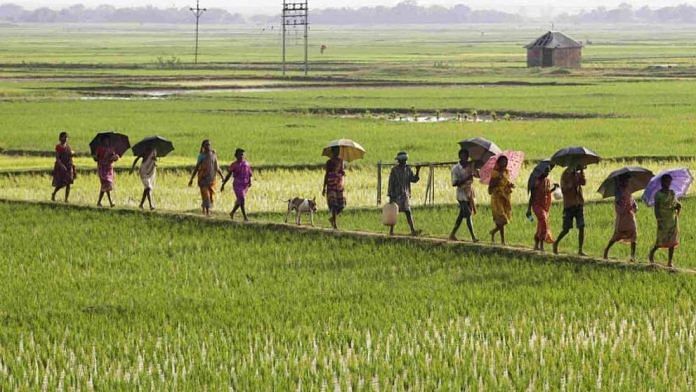New Delhi: If the Union Ministry of Agriculture has its way, farmers in traditional rice-producing states where groundwater levels have significantly dropped will find themselves forced to look beyond paddy.
With promotional exercises failing to effect a shift among farmers in states such as Punjab and Haryana, where heavy cultivation of water-intensive paddy has severely depleted groundwater levels, the ministry wants to enforce crop diversification by shrinking the central government’s assured quota of rice purchased from these regions, ThePrint has learnt.
The proposal also seeks to cover other rice producing states facing a similar problem, such as Andhra Pradesh and Tamil Nadu, two ministry officials familiar with the proposal told ThePrint. It is part of a five-year vision document that the agriculture ministry will present before Prime Minister Narendra Modi this week.
Currently, the Food Corporation of India (FCI) procures a fixed quota of rice from several states every kharif season for the National Food Security Mission, which was launched in 2007-08 to boost the production of paddy, wheat and pulses.
For example, of the total 42.99 lakh metric tonnes (MT) of non-basmati paddy produced in Haryana every kharif season, the FCI procures approximately 39.4 lakh MT.
In Punjab, the figure stands at 113.34 MT of 133.64 MT.
According to one of the ministry officials ThePrint spoke to, estimates suggest diversification to less water-intensive crops could save 20,000 to 30,000 lakh litres of water each kharif season in Punjab and Haryana alone. “This roughly translates to savings of Rs 27 crore in subsidies in transplanting season alone,” the official said.
Also read: Modi govt backs cow dung-based farming. Now its own officials call it a ‘myth’
A matter of water
India is the world’s second largest producer of rice and almost all states cultivate paddy. But in states like Punjab, Haryana, Andhra Pradesh and Tamil Nadu, excessive reliance on irrigation has severely depleted groundwater levels.
The vision document cites a 2018 study by the Indian Council for Research on International Economic Relations, a Delhi-based think tank, to explain the water crisis in some rice-growing states.
The study titled ‘Water Productivity Mapping of Major Indian Crops’ said, “…the high rice-producing north western-region of India comprising Punjab and Haryana and western Uttar Pradesh have been globally identified as the water risk hotspots thereby raising serious concerns regarding the medium-to-long term sustainability of irrigated rice production in India.”
It added: “This water issue will, in turn, affect the food security of India as the region contributes to above 50 per cent of the national stock of the staple rice in the country.”
Speaking to ThePrint, the two ministry officials said the states mentioned above consume “excessively large quantities of irrigation water causing water stress and economic distress”. Over 90 per cent of rice cultivation in these states is believed to rely on irrigation.
The new proposal, the officials said, seeks to reduce the area under rice cultivation in water-scarce states and provide subsidies to other producers, such as Jharkhand, Bihar, Chhattisgarh, Assam and Odisha, to bridge any shortfall.
According to the vision document, accessed by ThePrint, each unit of applied water for rice has higher productivity in these states, but the crop is often under-irrigated here or vulnerable to monsoon.
“The central government must increase the procurement quota from these states while increasing other incentives like power subsidies and providing access to mandis and warehouses at cheaper rates,” said one of the officials.
Diversification lags
The first official ThePrint spoke to said farmers in Punjab and Haryana had failed to diversify despite extensive promotion by the respective state governments.
“The acreage in Haryana under paddy crop in kharif 2019-20 was around 10 lakh hectares, down from 11.87 lakh hectare of kharif 2018-19. Compared to this, cotton-sowing just rose from 6.65 lakh hectares to 6.76 lakh hectares,” the official added.
In Punjab, only 1 lakh hectares of rice land was diversified to other crops like cotton and maize, the official said.
“There is a need for farmers in these states to shift to crops that are less water-intensive and do not put further stress on depleting groundwater levels,” the official added.
Also read: High time Indian farmers are freed from shackles imposed by 1960s’ food-shortage mindset
(The report has been updated to accurately reflect the amount of water that can be saved after diversification of crops.)




Nudge didn’t work, agriculture ministry now has a plan to force paddy farmers to diversify. Yeah, one of those Behavioral Economics BS. The man got a Nobel out of it. That’s all.
Why just paddy?! Why not sugarcane, the bane of rural Maharashtra. A handful of politicians control sugar mills and source cane from a small percentage of Maharashtra farmers who grow sugarcane. This is a politically sensitive issue since it may hurt rich farmers. BUT reducing or even eliminating sugarcane from rural Maharashtra could save scores of thousands of lives who kill themselves because of drought and crop failure…and the entire chain of borrowings from moneylenders and xxxxx. I Guess if they want to bring a policy, it should be integrated and should cut across crops and states, focusing on drinking water as a priority…